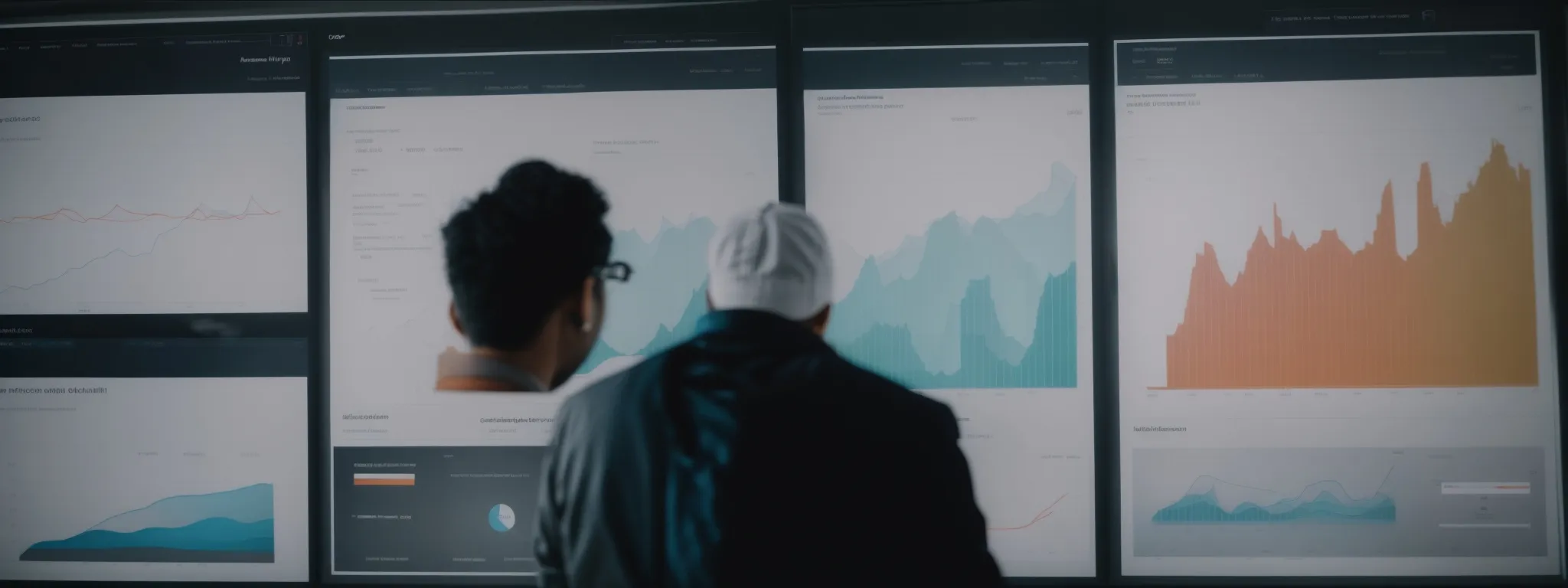Metrics that Matter in Digital Marketing
Key Performance Indicators for Successful Digital Marketing Campaigns In the dynamic world of digital marketing, assessing the success of a campaign hinges on a profound understanding of […]
Key Performance Indicators for Successful Digital Marketing Campaigns
In the dynamic world of digital marketing, assessing the success of a campaign hinges on a profound understanding of key performance indicators (KPIs).
These metrics not only illuminate the effectiveness of marketing efforts but also guide organizations in making data-driven decisions to optimize their strategies.
From conversion rates that reflect the persuasive power of your content to customer lifetime value that predicts long-term profitability, KPIs are the compass that steers the marketing ship towards its desired destination.
Keep reading to unlock the full potential of these crucial metrics and elevate your digital marketing to new heights of success.
Key Takeaways
- KPIs Provide a Deeper Understanding of Marketing Strategies by Reflecting Specific Objectives and Guiding Data-Driven Decisions
- Conversion Rates Are a Crucial Performance Indicator Within the Marketing Funnel, Signifying Strategy Effectiveness
- Traffic Source Analysis Is Key to Optimizing Marketing Reach and Understanding Consumer Behavior
- Customer Acquisition Cost (CAC) Is a Vital Measure of the Investment Required to Acquire New Customers and Informs Budget Optimization
- Return on Investment (ROI) Is the Ultimate Indicator of a Campaign’s Profitability and Efficacy Against Industry Standards
Understanding Key Performance Indicators in Digital Marketing

In the intricate landscape of digital marketing, Key Performance Indicators (KPIs) serve as Navigational Beacons, providing professionals with invaluable insights into the efficiency and impact of their marketing strategies.
Unlike standard metrics that track general data, KPIs are Tailored to Reflect the Success of specific objectives, enabling organizations to make data-driven decisions.
At the crossroads of technology and strategy, these quantifiable measures offer clarity on how marketing efforts resonate with the target audience.
With an understanding of KPIs, one can dissect the complex anatomy of a campaign’s performance, from visitor engagement to conversion rates, laying the foundation for Enhanced Digital Marketing ROI.
Distinguishing KPIs From Standard Metrics
Metrics in the digital marketing realm are abundant, yet not all hold the same value when pinpointing the success of a marketing campaign. Standard metrics may capture a wide array of data points such as pageviews or bounce rate, but they fail to contextualize the impact relative to specific business goals. KPIs differ significantly by being carefully chosen indicators that align directly with strategic objectives, guiding marketing teams in assessing how well their marketing efforts are meeting targeted outcomes.
Key Performance Indicators stand out due to their ability to convert raw data into actionable insights. Where simple metrics paint with broad strokes, KPIs drill down to specifics such as conversion rate or customer lifetime value (CLV), providing a more distinct and relevant measure of effectiveness. This focus allows an organization to track digital marketing success with precision and tailor future initiatives for optimal performance.
The Role of KPIs in Measuring Campaign Success
KPIs are instrumental in the dissemination of complex marketing data, transforming it into a streamlined narrative of campaign success. Through their application, a marketing team can transition from conjecture to certainty about specific aspects of their marketing activities, such as the efficacy of a new email marketing campaign or the reach and resonance of content marketing efforts.
Crucially, KPIs facilitate the interpretation of Digital Marketing Strategies, attuning companies to the real-time effectiveness of ad spend and user engagement. These indicators highlight which marketing channels yield the highest ROI, allowing companies to allocate resources strategically and maximize their marketing efforts across various platforms.
The Importance of Conversion Rate as a KPI

In the upper echelons of digital marketing efficacy, the conversion rate stands as a pivotal performance indicator.
Defined as the percentage of visitors who complete a desired action, this metric acts as a litmus test for the effectiveness of the marketing funnel, from initial interaction to final transaction.
A vital gauge of marketing health, a commanding conversion rate signifies a well-tuned strategy, speaking volumes about an organization’s grasp on the needs and behaviors of its audience.
As marketers seek to master this critical KPI, the exploration of robust strategies to enhance conversion rate performance becomes indispensable, allowing marketing campaigns to flourish and deliver measurable success.
Defining Conversion Rate in the Marketing Funnel
Within the structure of the marketing funnel, the conversion rate emerges as a definitive metric that quantifies the ratio of visitors to a website who take a predetermined, valuable action out of the total number of visitors. This vital statistic serves as a benchmark for the efficacy of the marketing strategy in guiding potential customers through various stages, from awareness to making a purchase or commitment.
Charting the journey from the top of the funnel, where awareness is generated, to the bottom, where decisions are made, conversion rate provides a snapshot of a digital marketing campaign’s ability to move a prospect to action. It directly reflects the resonance of marketing messages with the target audience, effectively measuring the persuasive power of the digital content and the user experience provided.
Strategies to Improve Conversion Rate Performance
An efficacious route to bolstering conversion rate performance is by refining the website’s user experience (UX). By simplifying navigation, expediting loading times, and ensuring mobile responsiveness, organizations can significantly reduce visitor frustration and abandonment, thereby fostering an environment conducive to conversion.
Employing A/B testing to compare different versions of a web page or marketing material allows marketing teams to ascertain which elements resonate best with the audience. Data gleaned from these tests can then guide the optimization of calls to action, landing page designs, and messaging to enhance the user’s journey toward conversion:
| Element | Variant A | Variant B | Conversion Improvement |
|---|---|---|---|
| Call to Action | ‘Buy Now’ | ‘Get Started Today’ | 15% Increase |
| Landing Page Design | Standard Layout | Minimalist Approach | 10% Increase |
| Messaging | Feature-Focused | Benefit-Driven | 20% Increase |
Monitoring Traffic Sources to Gauge Marketing Reach

In the digital marketing universe, the analysis of traffic sources is pivotal for unraveling the nuances of an audience’s online journey.
Each click, session, and engagement emerges from a traffic source; deciphering this information can illuminate the paths that potential customers traverse to arrive at a brand’s digital doorstep.
As organizations seek to refine their digital marketing strategies, the meticulous examination of various traffic channels becomes a cornerstone in their quest to optimize marketing reach.
Assessing the myriad of data points provided by these traffic sources lays the groundwork for informed marketing decisions and strategic adjustments that align with consumer behavior.
Analyzing Different Traffic Channels and Their Impact
In the realm of digital marketing, understanding the diverse traffic channels and their individual impact is vital for calibrating strategies that resonate with the intended audience. Traffic channels such as organic search, social media, and paid ads offer unique insights into consumer behavior and preferences, guiding marketers in crafting campaigns that effectively attract and engage potential customers.
Meticulous analysis of these traffic sources reveals not only the volume of visitors but also the quality of interactions and propensity for conversion. This scrutiny aids digital marketers in allocating resources where they yield the most significant influence, fine-tuning campaign objectives to maximize reach, and bolstering the overall efficacy of their digital marketing efforts.
How Traffic Source Data Influences Marketing Decisions
Dissecting traffic source data equips marketing professionals with the acumen to steer their digital campaigns toward success. It allows an agile response to user behavior, where strategies are refined based on the origin of website visitors, whether it be direct traffic, referral links, or specific search queries. Effectively interpreting this data ensures that marketing resources are channeled into the most fertile grounds for user engagement and lead generation.
By leveraging insights from traffic source analytics, companies can discern the pathways that lead to conversions and, therefore, prioritize channels with the highest ROI. For instance, if data indicates a surge in conversions from social media platforms, a company may allocate more of its ad spending to these channels to capitalize on the trend, ultimately enhancing the performance of its marketing campaigns.
Analyzing Click-Through Rates for Campaign Engagement

In the dynamic realm of digital marketing, the Click-Through Rate (CTR) functions as a vital performance metric, shedding light on the effectiveness of various communication channels in capturing the attention of the target audience.
By examining the frequency at which users are compelled to click on ads, links, or calls to action, CTR serves as a barometer for the engagement levels within marketing campaigns.
This core indicator, therefore, not only highlights areas of strength but also pinpoints avenues for enhancement, guiding marketers to deploy techniques that amplify engagement and ensure that every campaign resonates with its intended audience.
Understanding CTR in Various Digital Marketing Channels
Click-Through Rate (CTR) is an indispensable metric in gauging the potency of various digital marketing channels. It reflects the percentage of users who click on a specific link or advertisement compared to the total number of users who see it, furnishing marketers with a clear indication of the relative appeal and efficacy of different campaign mediums.
Integrating CTR data into a digital marketing strategy allows for a keen analysis of user responsiveness across avenues such as email marketing, PPC Google Ads, social media marketing, and display advertising. Each channel’s performance can be dissected to reveal insights that inform optimization efforts for improved audience engagement:
| Marketing Channel | Average CTR | Industry Benchmark |
|---|---|---|
| Email Marketing | 3.42% | 2.62% |
| PPC Google Ads | 5.06% | 3.17% |
| Social Media Ads | 1.3% | 1.1% |
| Display Advertising | 0.44% | 0.35% |
Techniques to Enhance Click-Through Rates Across Campaigns
Enhancing click-through rates (CTR) necessitates a meticulous approach to crafting advertisements that not only captivate but also prompt action. To achieve higher CTRs, digital marketers must create compelling ad copy paired with enticing visuals that resonate with their target audience’s needs and preferences.
Optimizing the targeting of campaigns plays a critical role in improving CTRs. By narrowing focus on segmented audience groups, marketers can tailor messages that address the specific interests and behaviors of those segments, leading to an increased likelihood of clicks and engagement:
- Analyze user data to create highly targeted ads that cater to the audience’s preferences and pain points.
- Test multiple ad creatives and formats to identify the most effective combinations for each audience segment.
- Employ retargeting strategies to re-engage users who have previously interacted with the brand, increasing the relevance and personalization of the ads they see.
Furthermore, monitoring and adjusting bidding strategies to ensure ads are optimally placed can influence CTR positively. Marketers should consistently review their bids and leverage automated bidding strategies to maintain a competitive edge in ad placement, thereby fostering higher click-through rates and campaign engagement.
Keeping Track of Customer Acquisition Cost

As businesses zealously pursue growth in the competitive digital marketplace, understanding the economics underpinning customer relationships becomes essential.
Customer Acquisition Cost (CAC) emerges as a paramount performance indicator, reflecting the aggregate cost of gaining a new customer across marketing campaigns.
It is the crucible in which the efficacy of marketing investments is tested, answering the critical question: How much does it cost to attract one paying customer?
By meticulously calculating CAC and incorporating its findings, organizations can harness the power to optimize marketing budgets with greater precision and foresight, ensuring that each dollar spent is an investment toward profitable customer engagement.
Calculating CAC to Evaluate Marketing Investments
In a landscape where prudent fiscal management is key, calculating the Customer Acquisition Cost (CAC) offers organizations a pragmatic lens through which to Evaluate the Return on Investment for their marketing campaigns. This crucial performance metric encapsulates the entire expense required to acquire a new customer, including costs associated with marketing and advertising, creative assets, and staff salaries, providing a comprehensive look at the efficiency of spending related to customer procurement.
By integrating CAC into their financial evaluations, companies gain a more nuanced understanding of their marketing strategy’s profitability. A lower CAC suggests a cost-effective approach in converting audiences into customers, whereas a higher CAC may signal a need for strategic realignment to optimize marketing resources and reduce excessive spending on customer acquisition endeavors.
Using CAC Data to Optimize Marketing Budgets
Customer Acquisition Cost (CAC) stands as a critical compass guiding marketing budgets towards the most efficient allocation. By examining CAC data, firms can identify which marketing channels and tactics yield the most cost-effective customer conversions, enabling a reallocation of resources to optimize overall marketing spend and improve profitability.
Effectively leveraging this knowledge ensures that companies maintain a strategic advantage, consistently refining their spending to foster both short-term gains and long-term relationships with their clientele. To this end, CAC data provides a robust foundation for judicious financial planning and targeted investment in high-performing marketing avenues:
| Marketing Channel | Customer Acquisition Cost | Percentage of Total Budget | Reallocation Decision |
|---|---|---|---|
| PPC Google Ads | $75 | 40% | Increase by 10% |
| Email Marketing | $50 | 25% | Maintain |
| Social Media | $90 | 15% | Decrease by 5% |
| Content Marketing | $65 | 20% | Increase by 5% |
Engagement Metrics That Reveal Audience Interaction

In the digital era where audience engagement serves as the lifeblood of a successful marketing campaign, the pursuit of meaningful interactions stands paramount.
Profound insights lie within engagement metrics, as they unfold the depth of audience interaction, ranging from time spent on a website to social media responses.
These metrics are critical for deciphering the nuances of user behavior, affirming their significance in crafting responsive and dynamic digital marketing strategies.
Together, they knit a comprehensive picture of consumer involvement, guiding marketers on how to foster connection and build lasting relationships with their audience.
Measuring Time Spent and Pages Visited Per Session
In the digital marketing space, the metrics detailing time spent on a site and the number of pages visited per session are critical barometers of user engagement. These figures point to how captivating and valuable the content is to the audience, indicating whether users find the website resources engaging enough to stay and explore.
Investigating these engagement metrics is akin to eavesdropping on the silent conversations between users and the digital content provided. Marketers discover which areas garner the most attention and which may require enhancements, stoking the fires of audience interest and website stickiness:
| Content Section | Average Time Spent | Pages Visited per Session | Insights for Improvement |
|---|---|---|---|
| Product Reviews | 4 minutes | 2.5 | Increase depth of reviews |
| Blog Posts | 2 minutes | 1.8 | Enhance visual content |
| Tutorial Videos | 5 minutes | 3 | Introduce interactive elements |
Analyzing these parameters allows marketers to fine-tune their site’s content strategy, driving up the metrics that signal a deepened user relationship with the brand. By focusing on what captivates their audience, businesses can strategically develop content that not only draws users in but also encourages them to stay, browse, and engage.
Interpreting Social Media Interactions and Their Importance
In the digital marketing ecosystem, social media interactions are not just mere numbers; they are a testament to the resonance of a campaign’s messaging. These interactions, which include comments, shares, and likes, provide an intricate view into the efficacy of content and its ability to provoke an active response from the target audience.
Analyzing these vital engagement signals equips marketers with the insights necessary to fine-tune their strategies and increase brand engagement. The importance of interpreting these metrics lies in their direct correlation with a brand’s ability to foster a thriving community, thereby amplifying its digital marketing success.
The Significance of Customer Lifetime Value as a KPI

In the intricate tapestry of digital marketing metrics, Customer Lifetime Value (CLV) emerges as a critical beacon, guiding marketers toward sustainable success.
With its roots firmly planted in both predictive analytics and behavioral insights, CLV serves as a forward-looking indicator, apotheosizing the total value that a customer is projected to bring to a company throughout their relationship.
The pursuit of cultivating higher CLV is underpinned by nuanced calculation methods and targeted marketing strategies, setting the stage for businesses to not only foster enduring customer relationships but also to elevate the profitability and longevity of their digital marketing campaigns.
CLV Calculation Methods for Digital Marketing Campaigns
Deploying the right calculation method for Customer Lifetime Value (CLV) is vital for digital marketers as it directly informs strategic decision-making and resource allocation. One popular approach involves analyzing historical data to evaluate average purchase frequency, lifespan, and profit margins per customer, thereby portraying the long-term profit potential a customer offers to the company.
Moreover, the use of predictive analytics models allows businesses to anticipate future behaviors based on past interactions, enhancing the accuracy of CLV estimations. Marketers can Integrate These Models to Tailor Marketing Efforts that not only elevate customer satisfaction but also strategically increase the anticipated value from each consumer relationship.
Increasing CLV Through Targeted Marketing Initiatives
Developing rapport with customers through personalized marketing experiences is a cornerstone of increasing Customer Lifetime Value (CLV). By deploying targeted email marketing and segmented social media campaigns, organizations can create a sense of value and belonging among customers, fostering loyalty and encouraging repeat business.
Strategic discounting and loyalty programs, tailored to reward long-term patronage, serve to entrench a customer’s commitment to a brand. Such initiatives are a testament to a company’s recognition of customer value, Catalyzing a Positive Feedback Loop that incrementally raises CLV and contributes to long-term revenue growth.
Return on Investment: The Ultimate Marketing KPI

In the realm of digital marketing, the paramount indicator of success is none other than Return on Investment (ROI).
This KPI is the cornerstone of campaign assessment, depicting the profitability yielded from each dollar invested in marketing endeavors.
Proficient marketers employ ROI as the litmus test for their strategies, applying sophisticated calculation techniques to unravel the true impact of digital campaigns.
Moreover, juxtaposing these findings against industry standards offers a clear vantage point from which companies can gauge the effectiveness of their efforts, ensuring they stand in league with or surpass competitors in the relentless strive for digital marketing triumph.
ROI Calculation Techniques for Digital Campaigns
Mastering the Art of ROI Calculation for digital campaigns demands a rigorous approach where revenue generated from marketing efforts is juxtaposed against the investment made. Typically, this involves identifying and summing up all the revenues that can be directly linked to the marketing campaign and then deducting the overall costs incurred during the campaign’s execution.
Digital marketers often utilize this critical assessment by adopting sophisticated analytic tools that track campaign-related sales and engagements. With precision, they attribute financial gains to specific digital marketing activities, allowing for a transparent view of each campaign’s financial footprint and the ensuing profit or loss.
Benchmarking ROI Against Industry Standards for Success
In the pursuit of digital marketing excellence, benchmarking Return on Investment (ROI) against industry standards offers companies a critical gauge of their campaign’s performance relative to competitors. By determining how their ROI stacks up in the broader industry context, organizations can identify opportunities for strategic improvement and competitive differentiation.
Staying attuned to industry benchmarks not only serves as a measure of success but also propels businesses towards innovative tactics to enhance their marketing returns. This aspirational benchmarking is instrumental in driving companies to refine their digital marketing tactics and achieve superior marketing effectiveness:
| Marketing Campaign | ROI Achieved | Industry Average ROI | Performance Relative to Industry |
|---|---|---|---|
| Email Campaign | 200% | 130% | Above Average |
| SEO Campaign | 175% | 150% | Above Average |
| Social Media Ads | 110% | 120% | Below Average |
Conclusion
In conclusion, Key Performance Indicators (KPIs) are the linchpin for a successful digital marketing campaign.
They provide clarity amid the complexities of digital marketing by focusing on specific objectives that align with business goals, thus enabling informed, data-driven decisions.
KPIs such as conversion rate, click-through rate, and customer acquisition cost allow marketers to dissect the effectiveness of various strategies and channels, adjusting and allocating resources for optimal performance.
Engagement metrics offer valuable insights into audience interactions, while analyzing traffic sources informs strategic choices.
Ultimately, Customer Lifetime Value (CLV) and Return on Investment (ROI) serve as comprehensive measures of a campaign’s profitability and long-term success.
By diligently tracking and optimizing these KPIs, organizations can master their market, drive growth, and sustain competitive advantage in the dynamic landscape of digital marketing.














































































